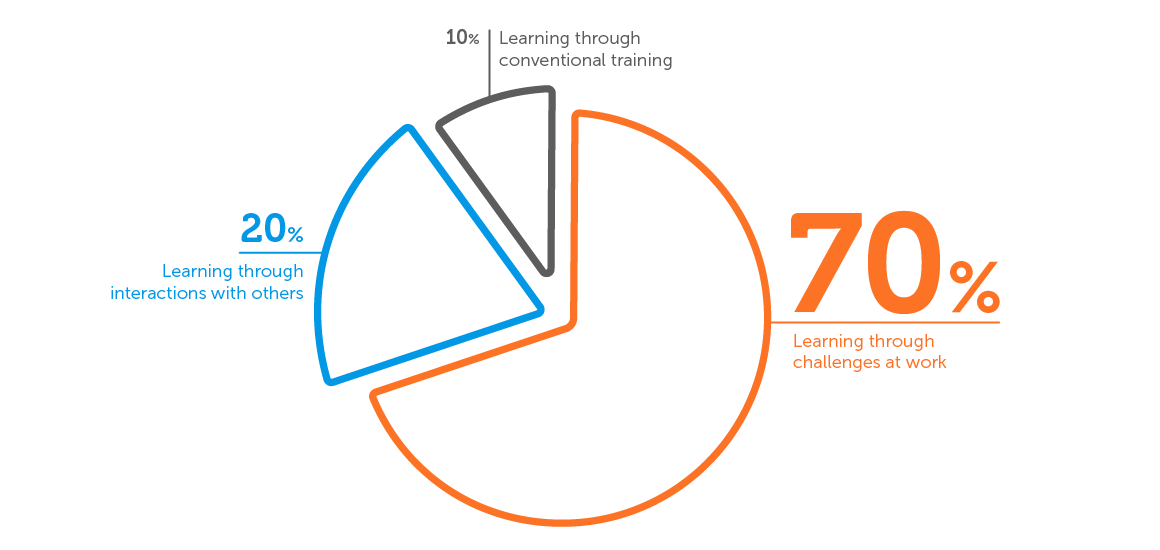70:20:10 – is this the formula for successful learning?
Show me similar content
Corporate Learning Learning Concepts Performance Support Knowledge Management
The world seems to be turning ever faster – and the direction of travel has been unpredictable for some time now. We see this in the progress of digitalization. We see this in the fall-out of the COVID-19 pandemic. For organizations to keep pace with all this, they have to exhibit a high degree of adaptability. However, this is only possible when staff are prepared for the requirements ahead using forms of learning that are effective and help them take the faster pace of everyday life confidently in their stride.
The basics of the 70:20:10 model
The 70:20:10 model was developed by Morgan McCall, Robert W. Eichinger and Michael Lombardo in the 1980s. As part of a research project, the employees of the U.S. Center for Creative Leadership asked around 200 managers where and how they had built up the skills they needed for their professional success. They published the results of the study jointly in their 1996 book “The Career Architect Development Planner”. They discovered that managers developed
- 70 percent of their skills through difficult tasks and challenges they have overcome in the course of their work (learning on the job)
- 20 percent of their skills through discussions with co-workers, supervisors and mentors (learning from other people) and
- 10 percent of their skills in conventional training using books and seminars (learning from courses and formal training) in which they build up their knowledge.
The results of this study have long been influential when it comes to professional training. Many organizations now use the 70:20:10 model in their staff development. For over 20 years, the Reuters news agency and Walldorf-based software giant SAP, for instance, have been pursuing the goal of using the 70:20:10 model to create appropriate learning environments within the work process that will help their staff grow into their jobs better.
70:20:10 – more a guideline than a strict rule
The model is not without its critics, however. For example, they point out that 200 respondents does not provide a sufficient empirical basis for far-reaching conclusions. The selection of the respondents is also criticized. It is reasonable to assume that the managers represented a relatively homogeneous group (especially in the 1980s) that would also consider itself particularly motivated and organized. As a result, no consideration was given to diversity. Furthermore, many people are uncomfortable with using clean, round numbers and a manufactured delineation between three types of learning that would, in reality, overlap. Some even speculate that many companies only adopt the 70:20:10 model for cost reasons, as providing less formal training in favor of more on-the-job learning saves money.
Not all of these points can be dismissed out of hand. However, it should also be borne in mind that the 70:20:10 model is not a rule that is set in stone with precise stipulations, or even a recipe. Instead, it describes a learning reality that has long been unknowingly practiced by employees of many companies. For this reason, it makes sense to examine your own professional training practices and use this model as a guide for designing a practical combination of cutting-edge learning opportunities that offer staff greater flexibility, responsibility and self-determination in their learning.
70:20:10 – learning situations in the mix
To this end, it is worth taking a closer look at the 70:20:10 ratio – that is to say, the different kinds of learning that collectively play a role in building up knowledge and developing skills.

It is very common for staff to learn by taking on difficult tasks and solving challenges that arise in the work process independently through their own drive.
70 percent – learning through challenges at work
It is very common for staff to learn by taking on difficult tasks and solving challenges that arise in the work process independently through their own drive. Staff therefore make the greatest and fastest progress through self-organized, informal learning in the workplace. Typical learning situations and progress in this context arise through:
- Challenging project work
- New tasks or areas of responsibility
- Job rotations, changes of position or working at another site
- Performance support with a digital adoption platform
20 percent – learning through interactions with others
In addition to solving problems in our everyday work, we also learn through interaction with co-workers – either by observing and imitating them or by targeted questioning to fill gaps in our knowledge or train ourselves to adopt new habits and behaviors. Online interactions – in team chats, using collaboration tools or social media, for example – play a key role in this, too. As with the 70 percent share, this 20 percent is also made up of informal learning in a work context. This includes:
- Coaching and mentoring programs
- Sharing in communities of practice, social networks, chats and discussion forums
- Team projects
10 percent – learning through conventional training
It may come as a surprise to many, but formal training only plays a relatively small part in building up knowledge in professional life. Nonetheless, it should not be neglected. For example, new recruits have little chance of doing their job efficiently without formal training. Unfortunately, certain roles, promotions and changes in position are still reliant on large numbers of formal training courses. To underline the importance of this 10 percent, some companies simply turn the formula on its head, working with a 10:20:70 model that emphasizes formal learning as the foundation for further measures. These include:
- Classroom events and seminars
- Online assessments
- Certifications
- Web-based training
Enabling learning while working
Don't get stuck in the 80's!
Key to understanding and strategically orienting concepts to this model is that informal learning often happens subconsciously and is based on the principle of self-determined learning. For staff development, this means a change in roles, as Charles Jennings, co-founder of the 70:20:10 Institute, explains in his blog: “Most ‘informal’ elements of learning can’t be managed, but can only be supported by HR/L&D .”
Those who are responsible for learning must therefore first understand that supporting informal learning is less about providing knowledge. Instead, the focus is much more on seeing the workplace as a central learning space and using ways of building up knowledge through practical application. In other words, HR officers must create the appropriate framework conditions for informal learning in the work process and stand side by side with managers in providing employees with the necessary freedoms to do this. After all, just because a member of staff primarily learns through practical experience, that doesn’t mean there isn’t a need for time to think, experiment, apply knowledge and discuss matters with others in their network. HR development staff and managers must therefore give up control and instead become enablers, supporters and accompaniers of informal learning if the model is to come to life in their company.
Five tips for integrating the 70:20:10 model in your company
The 70:20:10 model requires a holistic understanding of organizational learning that relies on a number of factors:

1. Training and raising awareness among managers
Together with HR, managers play a vital role in successfully implementing 70:20:10. It is therefore important to raise their awareness of the part learning plays in work and how they can support it.
2. From an event to a mindset
The majority of professional training measures are held as a one-off or extraordinary event. However, the 70:20:10 model shows that the greatest learning progress is achieved not through temporary measures but as part of a continuous process of problem solving in the workplace. Instead of ripping employees out of their working context and sending them to events, ongoing learning and development opportunities should be encouraged. This transformation will not happen overnight, and requires continued reflection on the part of HR, managers and learners alike.
3. Aligning learning opportunities with needs and skills
Informal learning is not a haphazard process – it always depends on the specific skills of the learner involved. It builds on existing knowledge, experience, attitudes and values, in addition to the framework conditions. New recruits and staff who are not yet familiar with the new learning opportunities therefore particularly benefit from targeted, formal courses, as these provide an introduction to the basics of the subject matter. As experience grows, so the need for guided learning falls away, in favor of informal learning. Employees who are already familiar with this expertly organize their learning process, using suitable pull formats on demand – including everything from performance support, learning laboratories and barcamps to feedback sessions, micro-learning nuggets and working out loud.
4. Encouraging and supporting learners
One advantage of informal learning over conventional seminars is the direct link to the actual activity and implementation in daily work. However, this doesn’t mean employees should be left to their own devices, because coaching and sparring from experienced learning companions can significantly increase the effectiveness of skills acquisition. The potential of learning from other team members or in communities of practice should not be neglected, either.
Although it is still a rarity in Germany, a key building block in self-determined learning is the willingness of organizations to unconditionally allow their staff learning times that they can access freely to enhance their knowledge and skills in their own field or explore a completely new area.
5. Trust instead of control
New learning can only be successful in a culture that offers employees the freedoms they need for it. Above all, this includes trust, as an intrinsic part of the 70:20:10 model is the realization that everyone is learning independently all the time – without having to fill out a request form first. In practice, however, this only works when managers and staff development officers let go of some of their control and decision-making power and open up more space for self-organized learning. This also includes having the courage to experiment and an error culture that sees failure as a valuable learning opportunity instead of punishing it.
Show me similar content
Corporate Learning Learning Concepts Performance Support Knowledge Management




